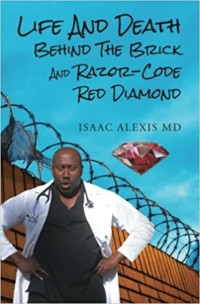Title: Life And Death Behind The Brick And Razor-Code Red Diamond
Author: Isaac Alexis M.D.
Publisher: Isaac Alexis
ISBN: 978-1-5353-4715-0
Pages: 101
Genre: Memoir/Health
Reviewed by: Carol Davala
Pacific Book Review
Living in South Jamaica, NY, Isaac Alexis learned to sleep with one eye open and one eye closed, in order to avoid becoming “a statistic in the hood.” His father was a gentle man who worked in the field of respiratory therapy for forty-five years. His mother, an ex-cop injured on the job, was a strong woman, clearly intent on raising her son with the well-known dictum of “spare the rod, spoil the child.” Alexis knew to avoid contact with the local neighborhood gangster types. Fearing his mother’s wrath, he understood the possibility of beatings so intense they would “make a ghost pepper seem like a cup of ice-cold vanilla ice cream.”
It was Alexis’ grandmother’s death from hypertension that ultimately influenced his desire to become a physician. Inspired by the workings of the brain, he chose to focus on correctional medicine. With an interest in using science to heal, while teaching how the body functioned and emphasizing proper care, he hoped to bring medical treatment to those with limited access. Life And Death Behind The Brick And Razor – Code Red Diamond provides a glimpse into the world of health emergencies behind bars, and the dedicated physicians who handle them. It was here that Alexis often found himself at odds with hospital doctors who suggested prison patients were only feigning illness. In his arguments about an inmate’s condition necessitating a move to a facility outside the prison, his words “I felt my hand slowly turning into a fist,” speak to his anger and frustration with such situations.
Readers will be drawn to the human interest side of Alexis’ writing, i.e. personal vignettes, family history, his efforts to avoid heading down the wrong path in his youth and individual case studies at the prison. His writing is often touched with elements of humor, particularly in recollections of childhood. In one such instance, a vivid memory depicts his grandmother catching and killing dinner on the Trinidad farm, with martial arts like antics he labels “Chicken Kwon do!” Unfortunately when the narrative switches to more clinical subject matter like Atrial Fibrillation or Deep Venous Thrombosis, the paragraphs seem a bit mired and weighted by technical jargon that would seem more suited to an audience with medical knowledge or expertise.
On a more positive note, broader topics like drug addiction, STDs and the opiate epidemic are handled through a more direct and simple approach. Here Alexis’ style is to talk more openly with readers, pose anticipated questions, then offer clear explanations.
In this compact volume, Alexis delivers a thought-provoking combination of personal memoir, medical information, tips on health and well-being and unique insight into the state of health care in the prison system. His personal vantage point offers up an enlightening behind-the-scenes view of correctional medicine. While many of those incarcerated may abuse the system to their advantage, Alexis’ writing aptly showcases the need for appropriate and diligent healthcare for individuals, no matter their life circumstances.


